Senses and communication: Non-human primate
Primate sensory capabilities and communication signals: implications for care and use in the laboratory.
Introduction
Understanding how non-human primates perceive the world and communicate among themselves is essential to providing high standards of housing, husbandry and care in the laboratory environment. Here we summarise the sensory capabilities of the non-human primates commonly used in the laboratory, highlighting important modes of communication, and identifying implications of these for designing and refining experiments, housing and husbandry systems and enrichment strategies.
More detailed information, including supporting references, can be found in the PDF version.
For information on interpreting the behaviour of macaques and marmosets, visit the NC3Rs Macaque Website and Marmoset Care.
Vision
Visual acuity and binocular vision
For most non-human primates vision is the dominant sensory modality. Monkeys, apes and humans have high visual acuity (ability to distinguish between closely-spaced visual stimuli). Behavioural tests demonstrate maximum acuities between about 40 and 53 c/deg for macaques and squirrel monkeys and 50 and 77 c/deg for humans. Forward-facing eyes with overlapping visual fields give excellent binocular vision and together these capabilities enable non-human primates to detect potential predators or harmful situations in the complex 3D forest environment, and to judge depth and distance when moving at speed between trees and branches. They also enable the accurate hand-eye coordination required for capturing fast moving insect prey or manipulating plant material.
Visual stimulation
Non-human primates are highly reactive to visual stimuli and make considerable efforts to gain visual information about their surroundings. They show a constant high level of attention to conspecifics. Housing and husbandry in the laboratory should take account of this.
- Whenever possible, rooms housing non-human primates should be provided with windows, since these can provide visual stimulation and are a source of natural light (Figure 1). Light intensity is important since it is positively correlated with activity, and affects fecundity (reproductive rate) in common marmosets.
- Doors and access corridors should also have windows, so that animals can see who is about to enter the room and when - this will prevent them being startled when staff appear unexpectedly.
- Mirrors can be used to allow non-human primates to observe activity in other areas, such as an adjacent corridor, and so expand the animals' visual environment - adjustable mirrors can be controlled by the animals, giving them a choice of what to look at (Figure 2).
- Where animals are housed in cages, two-tiers should not be used, so that all animals receive the same opportunities for visual stimulation and staff interaction, quantity and quality of light, and ability to retreat to a high perch.
- Motion in various forms, such as TV, video images or video games, can be used as visual stimulation for non-human primates. However, note that TVs and video monitors are designed with humans in mind and, since non-human primates differ in aspects of visual processing, such as visual acuity, colour vision and critical flicker-fusion threshold, other primate species may perceive video images differently.

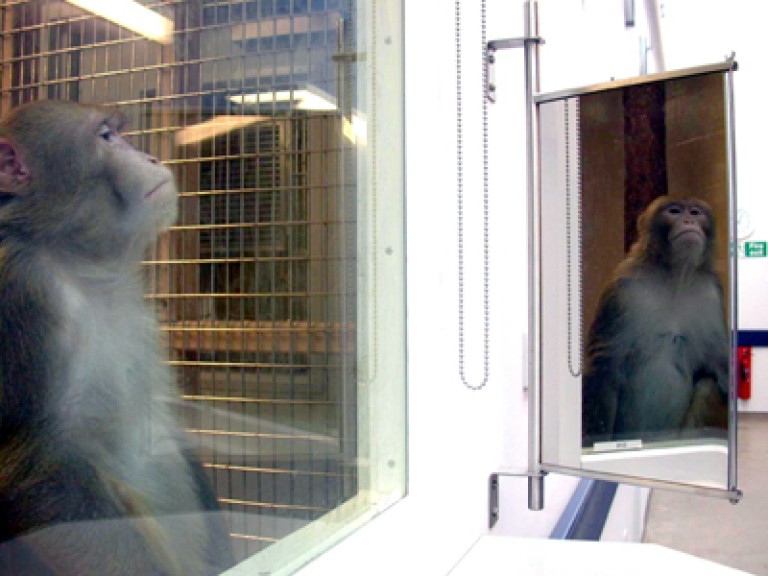
Colour vision
Most non-human primates have excellent colour vision. This is important for selecting food, detecting predators and for communicating with conspecifics. For example, adult male and female rhesus macaques undergo a hormonally-regulated reddening of facial and anogenital skin during the mating season. Experiments have shown that females exhibit preferences for red versus pale computer-manipulated male faces, and it is proposed that male colouration might provide a cue to male quality.
Apes and Old World monkeys, such as macaques, have full colour vision (trichromacy), similar to most humans. However, most New World monkeys, such as marmosets and tamarins, have polymorphic colour vision – in these primates, some females and all males have vision similar to ‘colour blind’ humans (dichromacy) (Figure 3).
- Coloured visual stimuli (e.g. photographs, slides and computerised images) should be used with caution in behavioural and cognitive studies involving New World monkeys (31) – colours that trichromats see as yellows, browns, greens, and reds may be all alike to dichromats.
- Similarly, when choosing targets for positive reinforcement training, colour should not be a cue that is used as it may not be as distrainable to the monkey’s eye as to the human eye.
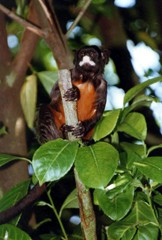
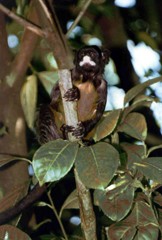
Night vision
The cone photoreceptors that are responsible for the ability to see colour in vertebrates only function effectively when in bright light. Consequently, diurnal vertebrates, including non-human primates, are more or less blind to colour in the dark of night. Whilst rod photoreceptors permit them to see at low light intensities (e.g. the faint light of the moon), colour differentiation is reduced.
- To enhance night vision and prevent animals from being startled, low level lighting should be provided for the changeover from light to dark (i.e. dawn and dusk periods) . This will also help prevent the serious injuries that can occur if animals are caught "mid-leap" when "on-off" lighting (i.e. without a dawn/dusk control) is turned off. Complete darkness should be provided for the night period as continued activity will occur when light, tiring the animals.
Visual signals
Visual signals are an important component of non-human primate behaviour, alone or in combination with vocalisations, scents or touching. Everything from the coat colour of an animal to the spacing between individuals can play an important role in determining behavioural responses. For example, the females of many Old World species, including macaques, baboons and chimpanzees, signal proceptive and receptive sexual behaviour with changes in the size, shape, turgidity and, often, colour of their perianal "sexual" skin (Figure 4). The reason for sexual swellings is not fully understood, but they may be a mechanism by which females signal their receptivity and fertility, to incite male competition and ensure that they get a good-quality father for their offspring. The sexual swelling increases in size as the female approaches the time in her cycle when she is due to ovulate, reaching its peak when the egg is released and she is at her most fertile. Female macaques also communicate sexual interest by approaching, following, and initiating proximity with, males. Soliciting behaviour in tamarins, and also marmosets according to some researchers, involves rapid tongue-flicking, which is displayed more frequently during the peri-ovulatory period. Tongue-flicking is also seen during agonistic encounters. Intra-group and inter-group agonistic encounters in marmosets often involve the 'tail raised present' behaviour pattern (Figure 5).
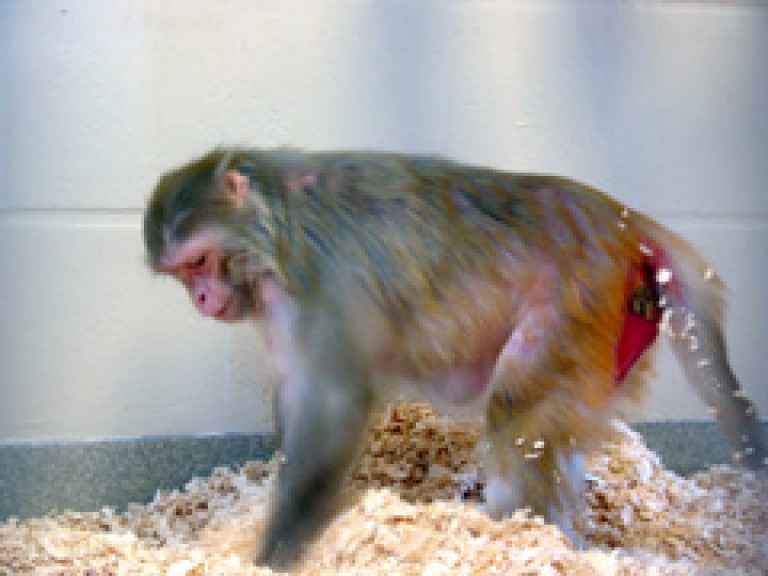
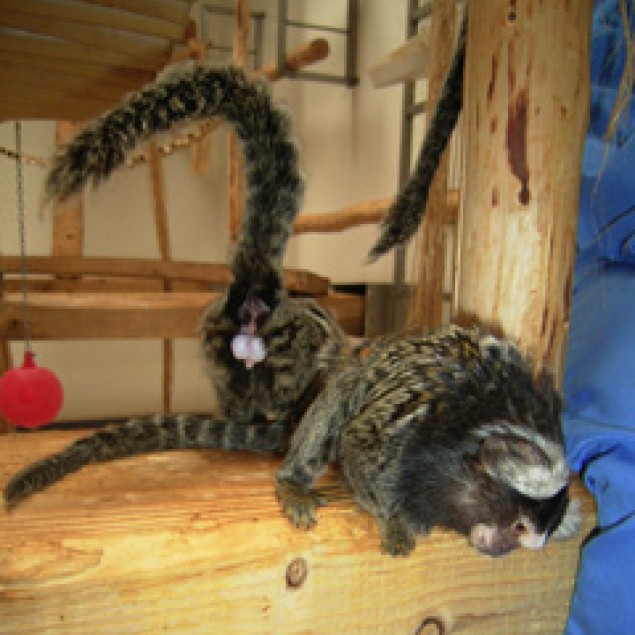
Old World primates use a diversity of facial expressions as well as gestures, athletic displays and body postures. In the macaques, most visual signals appear to revolve around issues of dominance and submission. For example, an open mouth gesture is a threat, whereas lip-smacking is a submissive or greeting gesture. The seeming casual yawn that exposes the canine teeth is a sign of tension or a threat ("look at my teeth"). An open-mouth grin is a sign of anxiety or fear and a means of diffusing tension, whereas a stare is a threatening gesture (Figures 6 and 7).
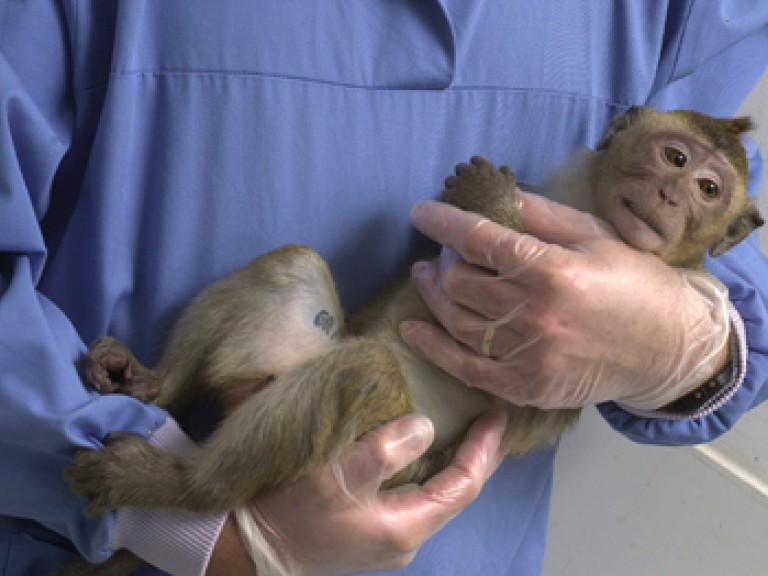
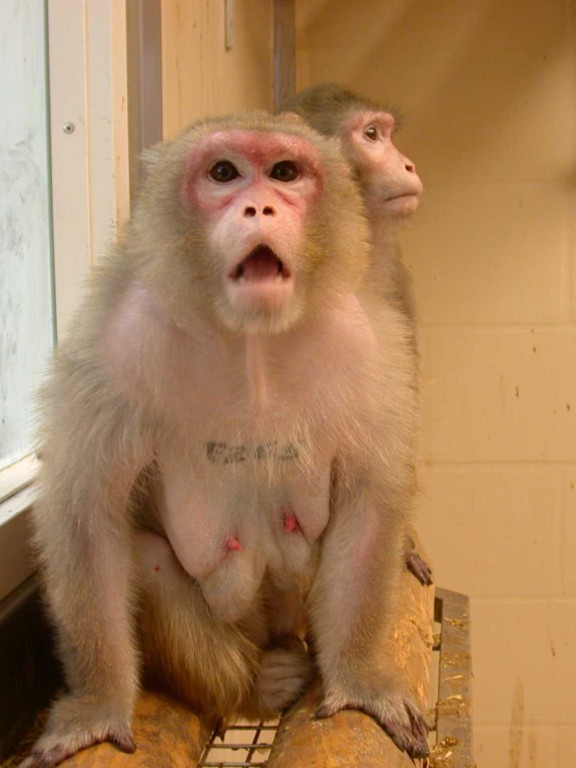
Compared with the Old World monkeys, the New World monkeys have traditionally been considered to have poorly developed visual signals and to not form the fine facial expressions seen in Old World monkeys. They do, in fact, have a rich repertoire of visual signals, but these may be less discernable due to their small size (Figure 8).
Some signals are common to all non-human primates, for example piloerection. Piloerection of the fur makes the individual appear larger than it actually is, and is used in aggressive interactions and can signify alarm and fear (Figure 9).
- Visual signals are the easiest signals for humans to recognise and can provide information on an animal's emotional and physical state (welfare), and his/her intended action in response to, and ability to cope with, a situation or social interaction. All staff coming into contact with non-human primates should receive training in recognising and understanding visual signals.
- Visual signals can also be used determine the relationships between individual animals which is useful when creating and monitoring social groups.
- Staff need to be aware of the importance of visual signals when group housing non-human primates or when arranging single housing caging - allow visual stimulation from conspecifics but provide some means of temporary visual seclusion (e.g. screens) for privacy and to allow the animals to have some control over their social interactions.
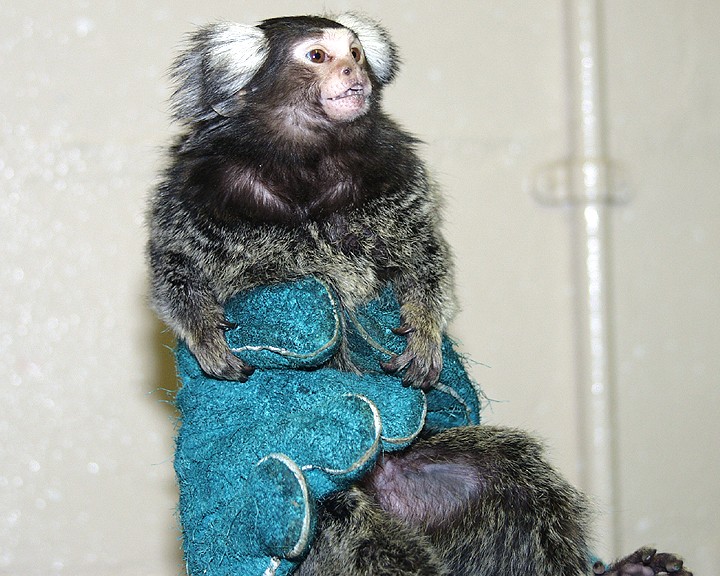
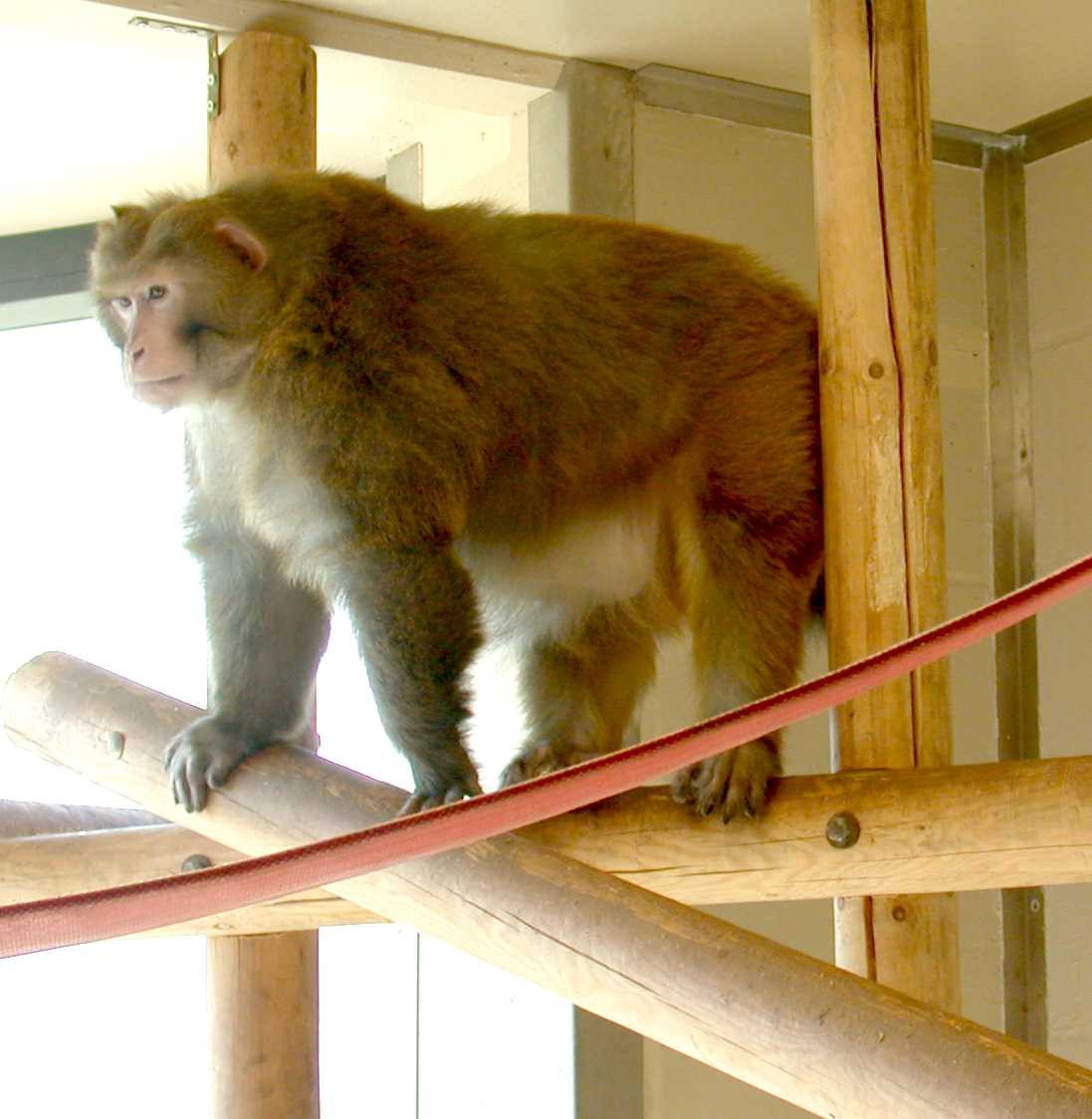
Non-human primates can learn socially through observation of their conspecifics or of other species, including humans.
- Behavioural scientists should be aware of this when designing learning paradigms and training programmes - for example, allowing animals to be observer the training of other animals may enable them to subsequently be trained more rapidly.
Non-human primates will react not only to the facial expressions, gestures and body postures of conspecifics but also to those of humans, as well as to negligible changes in human clothing. Staff should:
- Be aware of the potential negative effects of their behaviour on non-human primates and adapt their behaviour accordingly (e.g. by avoiding direct eye contact which can be perceived by the animals to be a threatening gesture).
- Engage in activity that communicates positive, as well as avoids negative, messages to the animals - for example, use of species-specific affiliative signals, combined with food provisioning, has been reported to reduce abnormal behaviour in macaques.
Smell
Olfactory sensitivity
Both New and Old World primate species have well-developed olfactory sensitivity, which for some substances matches or exceeds that of the rat or dog. The importance of olfactory stimulation in captive environments for non-human primates is often overlooked - many species are likely to benefit from being provided with enrichment items or foods with a variety of different scents (e.g. capuchins like to rub their bodies with scented objects such as garlic bulbs).
Olfactory communication
There is evidence from a number of non-human primate species for olfactory involvement in social behaviours, such as the establishment and maintenance of rank, defence of territory, identification of sexual partners, recognition of group members and communication of reproductive status.
Communication through olfactory means is particularly important for New World monkeys and prosimians, many of which possess odour-producing skin glands and demonstrate conspicuous marking behaviours (Figure 10). For example, in the squirrel monkey, hand washing with urine, nasal rubbing and sneezing, back rubbing and anogenital inspection all appear to be associated with olfactory communication.
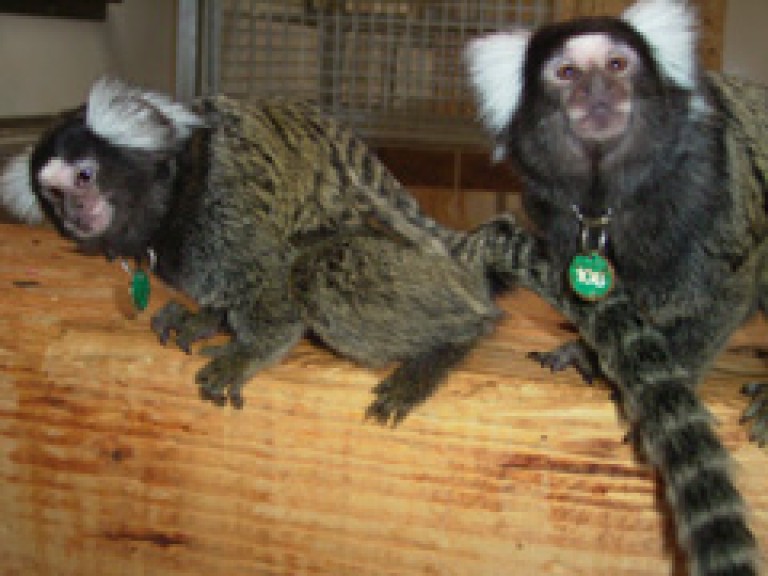
Preference tests have revealed that a wide variety of information is coded in the scent marks of marmosets and tamarins, including species, subspecies, sex, individuality, social status, hormonal status and timing of ovulation. Marking appears to have several functions including the reproductive suppression of subordinate females, advertisement of individual "quality" (mate attraction), preparing males to assist in the delivery and care of newborn infants, and territorial defence. Odours are effective for up to three days after deposition.
- Objects should be provided which allow marmosets and tamarins to mark their environment (e.g. wooden perches and ladders).
- Because of their role in modulating reproductive physiology and regulating social interactions, it is important that familiar scents are not totally removed from the captive environments of these species during cleaning. Alternate cleaning and sanitation of enclosures and enrichment devices will help to retain scent and has beneficial effects on the psychological well-being of the animals by reducing over-stimulated scent-marking.
- Scent-marking behaviour has been reported to increase following stress in common marmosets and, therefore, may be a useful non-invasive behavioural measure of stress in this species, along with locomotion and self-scratching .
Taste
Taste is one of the most important senses for efficient choice of foods in non-human primates and many consume a diverse diet (e.g. macaques may consume over 100 or more plant species in a year). In general, they show a positive response to sweet sugars (to maximise ingestion of beneficial substances) and an avoidance response to bitter plant compounds such as alkaloids and tannins (to minimise ingestion of substances most likely to be toxic). Species differences have been found in responsiveness to carbohydrates.
Although the salt concentration of most natural foods of non-human primates is below the taste threshold, they are sensitive to salts and have been found to discriminate concentrations of sodium chloride as low as 1 mM (spider monkeys), 20 mM (pig-tailed macaques), 50 mM (olive baboons) and 200 mM (squirrel monkeys). The detection threshold for humans is around 6-15 mM.
In addition to the four conventional taste qualities (bitter, sweet, sour and salty), electrophysiological work with macaques has also demonstrated neurons responsive to glutamate, responsible for the taste umami (savouriness), and tannic acid, which produces the taste of astringency and is of biological importance to arboreal primates.
- Given the highly developed sense of smell and taste and generalist diet of most primate species, providing a variety of palatable food types and tastes is likely to be beneficial for their psychological well-being.
- Genera and species preferences need to be considered in providing gustatory variety.
Hearing
Auditory sensitivity and sound localisation
All non-human primate species tested so far are able to hear frequencies below 125 Hz, meaning they have comparatively good low frequency hearing in common with the majority of mammals. The low frequency sensitivity of Old World monkeys is similar to that of humans, but they hear approximately an octave higher than humans do. The hearing of New World monkeys and prosimians is further shifted toward higher frequencies compared with Old World monkeys and humans - this is likely because high frequencies are more useful to small species than to large species for sound localisation (detecting the direction a sound is coming from). Macaques and squirrel monkeys have a minimum audible angle of around 5o, roughly similar to other mammals such as cats, pigs and opossums.
Ultrasound
At 60 dB SPL the highest audible frequency for the human is around 20 kHz, whereas for the common marmoset it is around 30 kHz, and for the squirrel monkey, rhesus macaque and long-tailed macaque it is around 42 kHz. Frequencies above the nominal upper limit of human hearing are termed 'ultrasonic'.
- The effects of laboratory sound at ultrasonic frequencies (e.g. from sources such as dripping taps, trolley wheels and computer monitors) may be a welfare problem. It is important therefore that any analysis of noise level should include ultrasonic frequencies.
Auditory stimulation and noise
Naturalistic sounds and music and have been used as auditory stimulation for non-human primates and can apparently have beneficial effects in terms of reducing aberrant behaviour and decreasing arousal. Auditory stimulation is apparently most beneficial when the animals have some control over it.
Under certain conditions, auditory stimulation can be aversive and turn into noise. Loud or unexpected noise has been reported to cause abnormal behaviour and physiological effects in non-human primates.
- For most species, satisfactory sound levels will be the same as those recommended for staff.
- Restful background sound, such as music or radio programmes, can be used to screen out sudden loud noises but it should not be provided permanently, should be kept at human conversational level and should only exceed 65 dBA for short periods.
- Noise producing equipment should be sited as far away from the animals as possible. Power hoses are very noisy and aversive to many non-human primates - dry cleaning should be used where possible, and the animals moved to a separate area before power hoses are used.
- Enclosures for non-human primates are commonly constructed of metal which is noisy - materials such as wood, laminates and glass have been used successfully to provide a quieter environment.
Vocalisations
Vocalisations are an important mode of communication for most non-human primate species, especially where visual contact is precluded (e.g. dense forest environments). Repertoires of vocalisations are relatively distinct between species and consist of a wide array of acoustic signals that can be defined by their frequency, intensity, spectral composition and duration. Examples of sounds produced by primates include the high-pitched, bird-like whirrs, chirps and twitters of the marmosets and tamarins and the grunts, barks, coos, geckers and screams of the macaques. Vocalisations of various non-human primate species, including cotton-top tamarins and rhesus macaques, can be listened to on the Primate Info Net website.
Using both field playback experiments and psychophysical methods, ethologists are beginning to understand how primates themselves perceive their species-specific vocalisations. For example, field experiments on rhesus monkeys have tested the ability of females to distinguish kin from non-kin using the 'coo' vocalisation. On the basis of the latency and duration of head orientating responses toward the sound source, females respond quicker and for longer to the coos of their kin than to those of non-kin or distantly related kin. Cotton-top tamarins, common marmosets and squirrel monkeys, like rhesus macaques, can identify individuals using only the acoustic cues of their calls. In fact, in non-human primates, differences in acoustic structure not only encode different call categories, but they also potentially encode information about individual, species, sex and group identity, motivational state, body size and reproductive status.
Some of the functions of vocalisations in non-human primates are to attract the attention of group members and to maintain a certain level of awareness among group members. For example, infants of many species produce isolation calls after becoming separated from their care-givers (e.g. isolation phee in marmosets, isolation peep in squirrel monkeys). Calling reflects the infant's emotional state, and attracts care-givers and induces them to retrieve the caller. Animals can also make non-vocal sounds, such as cage banging, to express their emotions.
Learning appears to play a role in the usage and comprehension of calls. For example, the appropriate response to, and hence the correct classification of, alarm and long-distance contact calls emerges at around 6 months of age in vervet monkeys and chacma baboons.
- Animal care staff can use vocalisations and non vocal-sounds produced by non-human primates to help evaluate their welfare.
- Non-human primates can readily distinguish between quiet, calm and loud, forceful human voice tones and words, which can be useful for training.
Touch
In common with other vertebrates, non-human primates are responsive to sensations such as touch, heat, cold, pressure and pain. They make behavioural choices based on these sensations, for example, marmosets prefer to use wooden and plastic nest boxes as opposed to metal ones, which may related to comfort and temperature, and will respond to soft materials (e.g. fleece) by rubbing their bodies against them.
- In outdoor enclosures the sense of touch is stimulated by environmental factors such as the sun, rain, and wind. In indoor enclosures, tactile stimulation can be provided by the materials composing the cage and items placed in the cage (e.g. wooden furniture, soft materials, browse, toys and food), as well as conspecifics. Note that marmosets and tamarins have claw-like tegulae and need textured substrates which they can grip onto (e.g. wood and mesh).
- Marmosets enjoy basking in warm sunlight - where it is not possible to include outdoor runs or windows, areas of additional heat/lighting can be provided indoors (e.g. heat lamps).
Several species of macaque are good swimmers and enjoy access to water. Where swimming pools are provided as environmental enrichment in the laboratory (Figure 11), these animals show high motivation to manipulate the water surface, immerse themselves, dive, swim and play (including underwater), even in the absence of submerged food rewards (e.g. raisins, nuts, banana chips).
- Consider providing macaques with swimming pools as sensory enrichment, on a periodic basis to maintain novelty. Advantages of this enrichment technique are that it is based on a natural behavioural inclination, encourages play rather than food-orientated enrichment, provides exercise, keeps both animals and their enclosure clean, and can facilitate thermoregulation in hot weather.
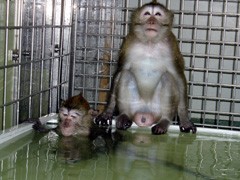
Manual dexterity
The fingers and hands of monkeys, apes and humans are highly sensitive and dexterous, allowing precise, delicate and diversified manipulation of objects. Old World monkey and apes have been observed to palpate fruit, such as figs, possibly testing for ripeness.
- Whole food manipulation may be an important part of the feeding repertoire of non-human primates. To increase foraging time and provide sensory stimulation, offer foods that the animals must process before eating (e.g. whole fruits, nuts in their shells, etc.).
Some non-human primates, such as capuchins and saddle-backed tamarins, are extractive foragers, using their hands to obtain foods (e.g. insects and small vertebrates) that are hidden in tree holes, rotting wood, termite nests, the base of palm fronds, bromeliads and embedded under bark. Several primates (e.g. capuchins, macaques and chimpanzees) also use tools to obtain food, in the wild and in captivity, which requires fine sensory and motor control.
- A variety of foraging devices to simulate extractive foraging behaviour, or manipulanda that require manipulation of moving parts, are commercially available or can be cheaply and easily made in house. These can be used to provide tactile stimulation for the animals and require them to work for their food, but their use should be monitored to ensure that animals are benefiting from them.
- A floor substrate, such as woodchip or straw, will provide tactile stimulation when foraging for scattered food.
Tactile contact with conspecifics
Tactile contact is very important for primates, especially early in life. Many species rest in contact (huddling) and this is probably a means of maintaining social cohesion in groups as well as reducing heat loss. This behaviour may be associated with pleasant sensations during infancy, since infant primates cling to their mothers (Figure 12).
- If non-human primates cannot be permanently group housed, tactile contact should be allowed with conspecifics (e.g. through grooming bars).
- Tactile and social contact with staff can be aversive for non-human primates that have not been adequately habituated and socialised to humans, especially prey species like marmosets and tamarins. Care should be taken to ensure adequate attention is paid to these learning processes during the early life of the animals, because positive interactions between staff and animals improve health and welfare and increase ability of the animals to cope with stress (Figures 13 and 14).
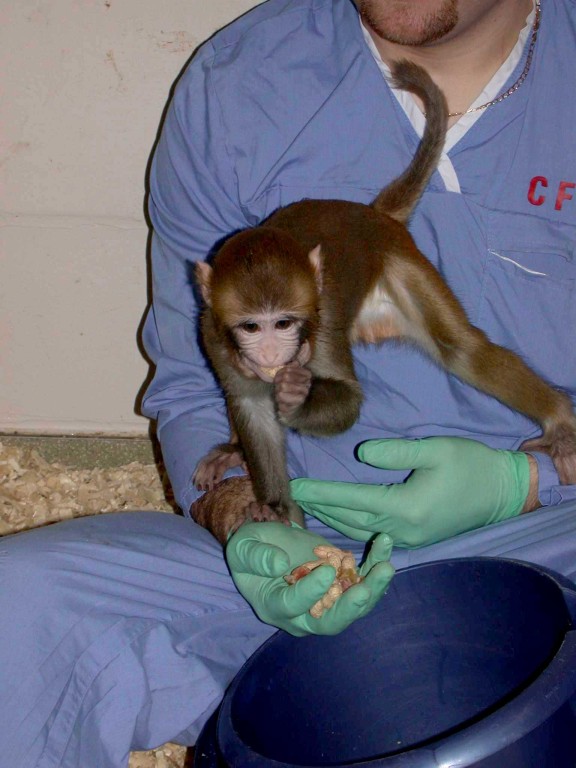
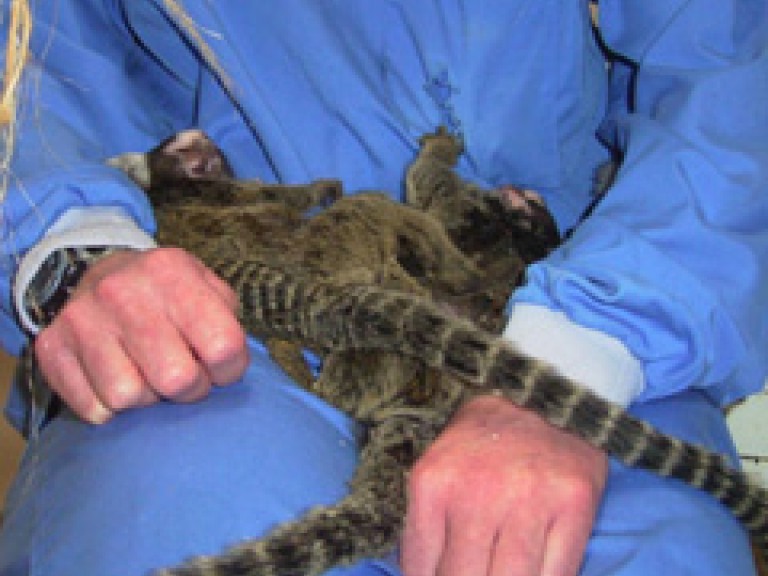
Grooming
Grooming is an important affiliative behaviour among non-human primate societies, reflecting the psychological well-being of individual animals and any grouping of them as well. Non-human primate species spend up to 20% of each day engaged in this activity. Grooming relationships are extremely valuable in helping animals to cope with the stresses of group life, and individual animals will make great efforts to maintain these relationships in the face of other demands on their time. For example, when food is scarce and animals are forced to spend longer foraging, baboons will sacrifice their resting time in order to keep up their grooming commitments.
- It is essential that habitats for captive non-human primates be designed to facilitate grooming and huddling by providing suitable space for housing with compatible social companions and a sufficient number of resting surfaces for animals to occupy simultaneously. Wide flat surfaces are preferred grooming sites for tamarins and other primates.
- Singly housed animals can be provided with fleece grooming/foraging boards to address their motivation for social grooming (Figure 15) - these have been found to significantly reduce abnormal behaviours, such as hair pulling, in macaques.
- For animals well socialised to humans, grooming from staff members can be used as an alternative to food-based rewards for positive reinforcement training.

Grooming helps to relieve the stress that builds up as a consequence of competition within social groups. This is important because high levels of stress reduce a female's fertility. Grooming also plays an important utilitarian role in cleaning the hair free of parasites and detritus and in some species (e.g. macaques) is used as an appeasement gesture to reassure individuals that an animal has no aggressive intentions. In macaques, higher-ranking individuals are reported to receive more and longer-lasting grooming sessions from low-ranking individuals than vice versa. In both the field and in captivity, male marmosets groom females significantly more than vice versa.
- The direction of grooming can be used to ascertain the hierarchy in a group of macaques and bonds between individuals, which can be useful for animal management.
- A change in the pattern of grooming (e.g. decreased self-grooming leading to an unkempt coat, or increased grooming attention from conspecifics leading to hair loss) may be indicative of a welfare problem - staff members should be aware of this and seek expert advice if they have concerns.
